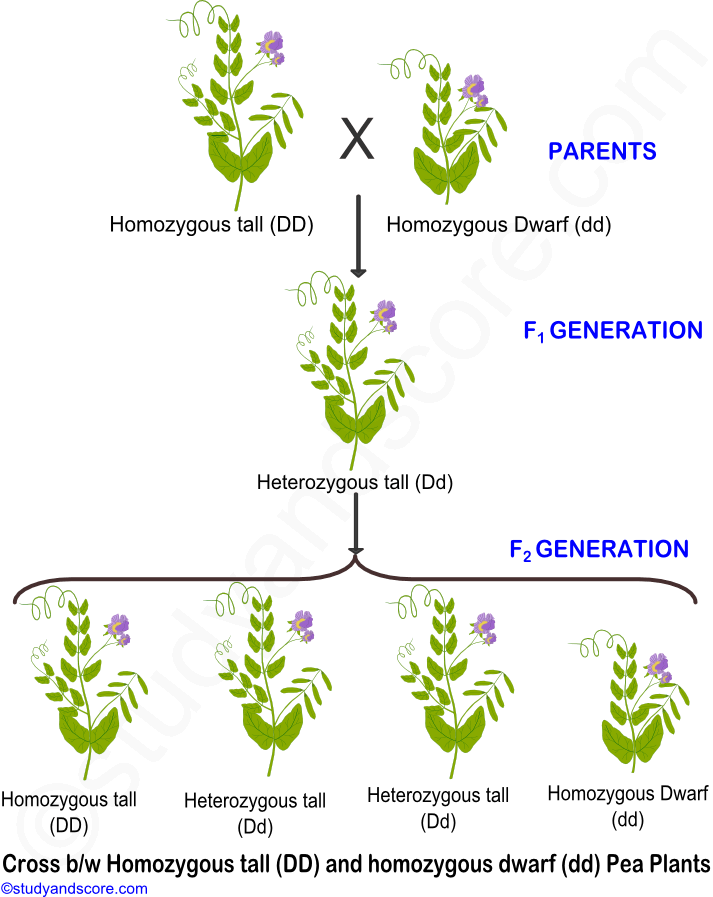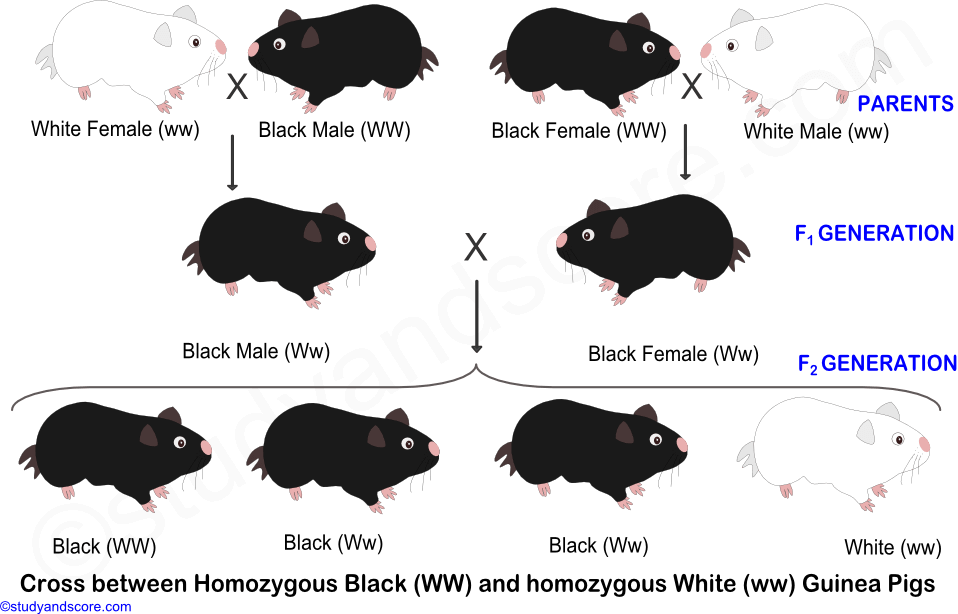Monohybrid cross: A genetic cross between parents that differ in single pair of contrasting characters, controlled by one particular gene is called as Monohybrid cross. One parent is having two dominant alleles and the other parent is having twp recessive alleles. All the F1 generation progeny have one dominant and one recessive allele for that gene i.e. they are hybrid at that one locus. Crossing between the F1 generation progeny yields a characteristic 3:1 ratio in F2 generation. The genotypic ratio in monohybrid cross is
Dihybrid cross: A genetic cross between parents that differ in two pairs of contrasting characters, controlled by genes at different loci is called as dihybrid cross. Mendel executed a dihybrid cross using the characteristics like seed color and texture of pea plant. The parental plants had either smooth yellow seeds (SSYY)-dominant characters or wrinkled green seeds (ssyy)-recessive characters. All the offsprings had smooth yellow seeds being heterozygous (SsYy) for the two alleles. Crossing between these F1 offsprings produced an F2 generation of plants with smooth yellow, smooth green, wrinkled yellow and wrinkled green seeds in the ration 9:3:3:1. These results formed the basis of Law of Independent Assortment.
Monohybrid and dihybrid crosses proved three principles of genetics,
Each of these crosses yielded approximately 3:1 ratio in the second filial generation. The three basic principles of inheritance were established by Mendel monohybrid crosses.
According to the law of dominance when two dissimilar unit factors are present in an individual then only one expresses itself while the other is completely masked. The one which expresses itself is called dominant character and the one which is unable to express itself is called as the recessive character. Mendel proposed this law of dominance based on this observation that F1 progeny had the appearance of only on parent; this is because of the dominance of one trait over the other.
When Mendel made monohybrid cross between tall and dwarf pea plants then only tall pea plants appeared in the F1 generation. But when the F1 progeny were allowed to be self-fertilized, both tall and dwarf characters appeared in the F2 generation. This shows that in F1 hybrids the character of tallness is dominant and this conceals the character of dwarfness and so the character of dwarfness is not expressed in F1 generation. The character which expresses itself in F1 generation is called by Mendel as Dominant character while the character which remains unexpressed is called as recessive character. Even after Mendel several genetic experts confirmed the validity of this phenomenon of dominance on several animals and plants.
Apart from the pea plants as tested by Mendel, the phenomenon of dominance is observed in the below given list of plants.
| Plant | Dominant character |
Recessive character |
|---|---|---|
| Nettle | Serrated leaves | Smooth margined leaves |
| Sun Flower | Branching | No branching |
| Cotton | Colored lint | White lint |
| Maize | Round starchy kernel | Wrinkled sugary kernel |
| Snapdragon | Red flower | Non red flower |
| Barley | Absence of beard | Presence of Beard |
| Wheat | Susceptibility to rust | Immunity to rust |
| Tomato | Two celled fruit | Many celled fruit |

When homozygous black guinea pig is crossed with a homozygous white guinea pig then all hybrids of the first filial generation are found to be black. When black hybrids of the F1 generation are mated among themselves, they produce black and white offsprings in 3:1 ration. This shows that the black coat color dominates over white coat color. Other examples of dominance in animals are tabulated here under
| Animal | Character | Dominant | Recessive |
|---|---|---|---|
| Land Snail | Shell shape | No banding on shell | Banding on shell |
| Sheep | Wool | White | Black |
| Salamander | Body color | Dark color | Light color |
| Cattle | Horns | No horns | Horned |
| Cat | Length of hair | Long hair | Short hair |
| Dog | Skin color | Grey | Black |

Even in Man many dominant and recessive characters have been reported. These dominant and recessive characters can be normal, abnormal and sex-linked characters.
Normal characters- These characters always behave as dominant and recessive.
| Body part | Character | Dominant | Recessive |
|---|---|---|---|
| Skin | Color | Dark | Light |
| Eyes | Color | Brown | Blue |
| Hair | Color | Dark | Light |
| Hair | Form | Curly | Straight |
Abnormal characters- These characters occur unusually as dominant and recessive.
| Body Part | Dominant | Recessive |
|---|---|---|
| Hair | Absent | Present |
| Ear Lobe | Free | Attached |
| Ears | Normal hearing | Deaf |
| Fingers | Short | Normal |
| Tongue | Ability to role | Ability to role |
| Teeth | Absent | Present |
| Eyes | Opaque lens | Normal |
| Skin Epidermis | Thickened | Normal |
Sex linked characters: Sex of the individual determines certain dominant and recessive characters.
| Character | Dominant | Recessive |
|---|---|---|
| Color vision | Normal | Color blind |
| Blood clotting | Normal | Hemophilia |
After carefully studying the results of his experiments Mendel was sure that there is some difference between the actual visible character and one which is causing its production. He thought that there must be something which represents the characters and which is responsible for the production of the character, because the character cannot be present as such in the sex cells which are the only link between the parents and the progeny. This something which Mendel thought is now called the factor or gene.
The genes are the units of inheritance which are transmitted in the sex cells and these genes determine the character in combination with other genes, cytoplasm of the cell and also the environment. The genes are the units of DNA, RNA and other nucleoproteins; all these constitute the thread like chromosome. The chromosomes are specific in number, shape and size in particular species.
A diploid cell has two sets of chromosomes which come from two parents through the sperm and ova. The chromosomes of similar size and nature form pairs during the meiotic cell division and such identical chromosomes are called as homologous chromosomes. When a gene for unit character contains two or more alternative forms, then they are called allelomorphs or alleles. The alleles of the gene are produced due to mutation of the normal gene.
For example, the homozygous tall pea plant has two identical alleles ‘TT’ on both gene loci of homologous chromosomes and the homozygous dwarf pea plant has two identical alleles ‘tt’ on both gene loci of homologous chromosomes. During gametogenesis, the homologous chromosomes with TT or tt genes separate and each chromosome with T or t gene is passes onto the gamete. The gametes of each parent unite during the process of fertilization and produce the progeny having both tall (T) and dwarf (t) characters. The progeny of the first generation contains two different genes of contrasting characters and thence it is known as the hybrid. Because the hybrids of the F1 generation have tall stems (the character of tallness) T is considered as dominant and because the character for dwarfness could not express itself in F1 generation, t is called as recessive.
Incomplete dominance: Sometimes a heterozygous dominant allele does not completely mask the phenotypic expression of the recessive allele and there occurs an intermediate phenotype. This is called as incomplete dominance.
Example: Red flowered pea plant crossed with white flowered pea plant, Pure line red petal snapdragon crossed with pure line white petal snapdragon
Co dominance: Sometimes both alleles of a gene in heterozygote lack dominant and recessive relation, in other words both the alleles are capable of some degree of phenotypic expression and this result in co dominance. In this type the heterozygote genotype gives rise to a phenotype completely different from either of the homozygous genotypes.
Example: Coat color of shorthorn breed of cattle, Inheritance pattern of human sickle-cell anemia.
Hope you have liked this post.
Please share it with your friends through below links.
All the very best from Team Studyandscore
“Study well, Score more…”
- Share with your friends! -
Login to post your comment here...
- or with social Account -